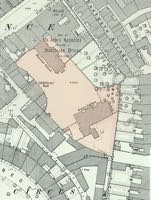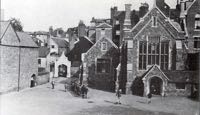
St John's Hospital School – near Eastgate
Page updated 19th March 2018
 Around about 1238, the Long brothers, who are remembered through the naming of the Longbrook, and Longbrook Street, endowed a hospital
dedicated to St John the Baptist, inside the city wall, by the East Gate. As was common at that time, the hospital was a religious
foundation housing five priests, six singing boys and twelve poor people. After the Reformation of the 1530's, the hospital was shut and
the buildings used for among other things, a gunpowder store, a workhouse, and a fleece market.
Around about 1238, the Long brothers, who are remembered through the naming of the Longbrook, and Longbrook Street, endowed a hospital
dedicated to St John the Baptist, inside the city wall, by the East Gate. As was common at that time, the hospital was a religious
foundation housing five priests, six singing boys and twelve poor people. After the Reformation of the 1530's, the hospital was shut and
the buildings used for among other things, a gunpowder store, a workhouse, and a fleece market.
Blue Boys and Heles School
It was in 1633 that the old hospital buildings were first used as the Free Grammar School for teaching Latin and Greek, a charitable foundation started by Exeter Corporation and the English Free School. A uniform of blue caps and gowns were introduced for the boys of the Free Grammar School, leading to the boys being nicknamed Blue Boys. At least five small statues of a Blue Boy were made, and one was placed at the entrance to the main hall, and one placed in the High Street. There was a major rebuilding of the St John's site in 1859. In 1880, Bishop Temple formed the Free Grammar School for 'what was essentially a school for tradesmen and the better class of working men'. The school was moved to a new 25 acre site in Victoria Park Road, to become the Exeter School.
Heles School was formed from a spin off of the English Free School, which moved to a new site opposite St David's Church in 1840.
Meanwhile, the St John's Hospital School the range of buildings on the high Street were demolished to be replaced by the Eastgate Arcade, and coffee house, and the new main post office in 1880.
The Twentieth Century
However, the school buildings at the rear of the demolished St John's Hospital School continued into the 20th century as a fee paying school. The charge in 1909, was 4 shillings per term rising to 5 shillings for older boys (40 pence and 50 pence respectively). The boys entered through a small gate, let into a large gate at the end of the Arcade on the High Street. This school had five classrooms, in buildings around a central playground, one of which, a large hall housed three classes divided by curtains that could be drawn aside. In 1928 there was an attempt to re-organise the school to become a senior boys' school. The efforts to keep it open failed, and newspapers reported in 1930 that the Governors of the school intended to close the school and sell the site. The school closed in August 1931, and last pupils transferred to other local schools.
The closing of the school was because the Governors were unwilling "... to face the expenditure involved in making it fit for the purposes" of a senior school. And thus, the end came as a school for the old buildings.
The buildings did not sell at auction, bidding having gone up to £12,500. In 1933 the Mayor's Workshops for unemployed men was running at the St. John's Hospital School premises. At the same time, archeologists excavated the site, uncovering the base of the hidden Roman, city wall.
Gone Forever
The May 1942 bombing destroyed the ancient school buildings, along with just about every other building for several hundred yards around it. When Princesshay was opened in the 1950's, the Blue Boy statue that stood outside of the school was salvaged and placed on a plinth in the precinct, at a spot that marked the position of the main entrance of the school.
Sources: British Newspaper Archive, Exeter Past by Hazel Harvey, Two-Thousand Years in Exeter by W G Hoskins.
│ Top of Page │

